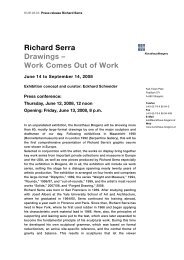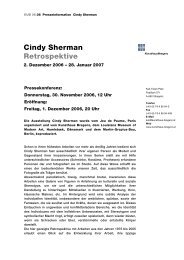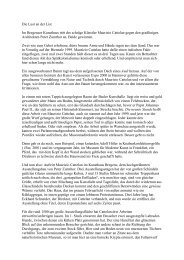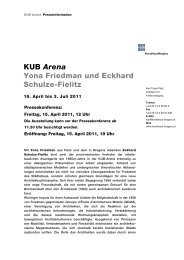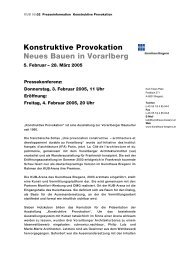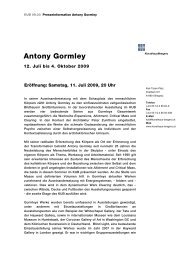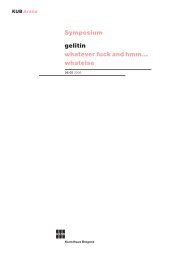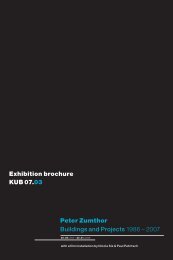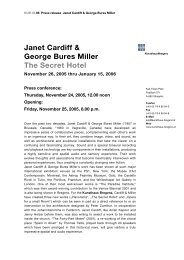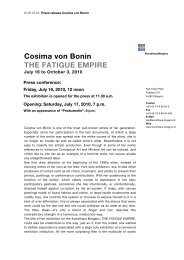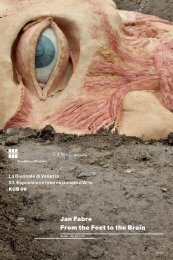Lothar Baumgarten Seven Sounds / Seven Circles KUB 09.02
Lothar Baumgarten Seven Sounds / Seven Circles KUB 09.02
Lothar Baumgarten Seven Sounds / Seven Circles KUB 09.02
Erfolgreiche ePaper selbst erstellen
Machen Sie aus Ihren PDF Publikationen ein blätterbares Flipbook mit unserer einzigartigen Google optimierten e-Paper Software.
Baumgar ten’s later work depar ted more specifically from his 18month<br />
sojourn with the Yanomami people in the Upper Orinoco<br />
Region in the years 1978 – 80. With the shift from fantasmatic<br />
projection to real, lived experiences, <strong>Baumgarten</strong> investigated how<br />
ethnographic material – and photography in particular – was to be<br />
presented. <strong>Baumgarten</strong> began taking photographs of the Yanomami<br />
after living among them for eight months, and he has presented the<br />
ensuing images in diverse formats. Produced in collaboration with<br />
the typographer Walter Nikkels, publications such as Makunaíma<br />
(1987) and Tierra de los Perros Mudos (1985) experiment with<br />
the hybrid relationship between image and text as a way of problematizing<br />
the myth of photography’s autonomy and objectivity.<br />
In the mid-1990s, the politics of identity became increasingly<br />
aligned with what Hal Foster termed the “artist as ethnographer” as<br />
a paradigm for contemporary art. Yet for <strong>Baumgarten</strong> ethnography<br />
is not simply a methodology to be applied to a contemporary social<br />
issue. That is, the physical experience of space remains crucial for<br />
his work’s presentation. His projects at the Fridericianum in Kassel<br />
(1982) and at the Carnegie Museum in Pittsburgh (1985 – 88) used the<br />
neoclassical dome and glass panel ceiling of these two buildings as<br />
support, while the inscribed names of native populations and their<br />
achievements were made to resonate in these so-called “universal”<br />
spaces of culture. Here the physical site of intervention (the museum)<br />
was inextricably tied to the site of the work’s critical effect (the<br />
history of ethnocentrism).<br />
For his current exhibition <strong>Seven</strong> <strong>Sounds</strong> / <strong>Seven</strong> <strong>Circles</strong> at<br />
Kunsthaus Bregenz, <strong>Baumgarten</strong>’s point of departure is Denning’s<br />
Point, a heavily wooded and overgrown peninsula on the east bank<br />
of the Hudson River. Part one of the exhibition includes three slide<br />
projections with images of this wasteland, former site of the Denning’s<br />
Point Brick Works Company. In the course of viewing the 404 slides,<br />
the visitor will discern the dynamics of growth and change made<br />
visible through the vegetation’s abstract compositions and also<br />
notice the subtle traces of industr y still scattered throughout the<br />
area. The exhibition’s second part includes seven sound pieces,<br />
each one hour in length, and similarly recorded on the peninsula.<br />
Presented in discrete spaces and under varied lighting conditions,<br />
these “phonic sculptures” provide an expansive sense of site<br />
through their atmospheric presence and unexpected merging of<br />
sound patterns, both natural and cultural. Indeed, what <strong>Baumgarten</strong><br />
describes as a “dramatic dialogue between culture and nature”<br />
speaks to the ongoing coexistence of the two in this region, while<br />
the work’s instantiation pushes the limits of our expectations of<br />
what we think we can hear. Kaira Cabañas<br />
<strong>KUB</strong>0902_HeftEin_<strong>Baumgarten</strong>_gzd.indd 11 06.03.2009 12:39:25 Uhr




